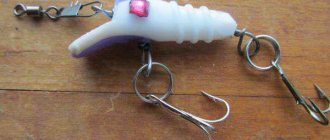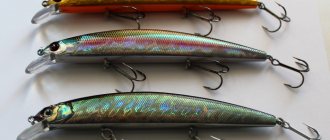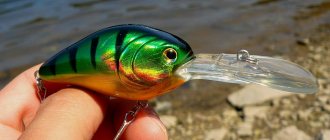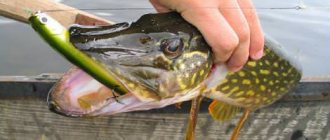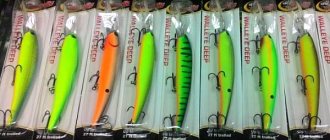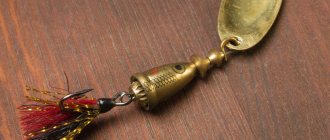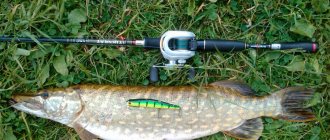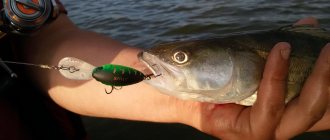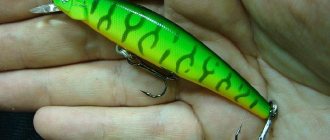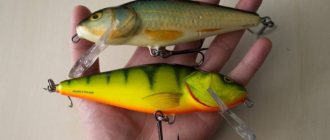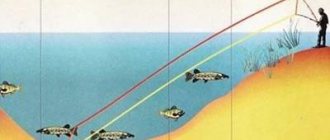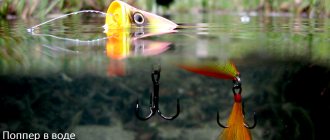Classification of wobblers by buoyancy
Depending on how the wobbler behaves in the water after casting, three main types of bait can be distinguished.
Floating
If, after falling into the water, the wobbler floats on the surface, then this model is of the floating type. The following wobbler designations are used:
- SF – Slow Floating;
- F—floating;
- FF - Fast Floating.
Drowning
If a wobbler that has fallen into the water sinks to the bottom, then this bait is suitable for the sinking type. Lures of this type are compact and heavy, they have good flight properties.
Designated as follows:
- S – sinking (Sinking);
- SS – Slow Sinking;
- FS – fast sinking FS (Fast Sinking).
Suspenders
When a wobbler falls into the water, slightly sinks into the water column and hangs in it, then such baits are usually called suspenders or suspenders. It is enough to add a carabiner and the suspender will begin to slowly sink. These wobblers have the following designations:
- SP - neutral buoyancy (Suspending);
- SSS – Super Slow Sinking.
Each of the listed types of wobblers is used under different conditions for catching predators.
Types of suspended wobblers, their markings and principles of structure.
You can determine that the wobbler you are purchasing belongs to the type of simulator with neutral buoyancy by the marking applied on the body of the bait in the form of the letter expression SP . Note that sinking wobblers are marked with the letter S, and floating models with the symbol F.
In addition to the abbreviation presented above, wobblers are divided into narrower characteristics in terms of buoyancy parameters, of which the last two are classified as suspenders.
- SF – slow floating.
- SS – slow sinking.
- SSF – super slow floating.
- SSS – super slow sinking.
Despite the similarity in shape and size, even suspenders of the same type are unique baits with their own moving characteristics and individual aerodynamics. Therefore, after purchasing a wobbler, it is worth carrying out mandatory testing, the purpose of which will be to reveal the main capabilities of the bait, which can subsequently be used in real fishing conditions, adapting to the criteria of the reservoir and the behavior of the predator. The neutral buoyancy of the product is achieved by a high degree of balance of the bait, which the manufacturer achieves by installing an air chamber in the body of the simulator, filled with weights, most often in the form of metal balls, holding the wobbler in a certain water horizon. In addition to balancing, the camera plays a dual role, creating additional noise effects during animation that help attract fish to the wiring area. Also, the size of the load determines the range of the suspender and stabilizes its progress on reservoirs with moderate and strong currents. The advantages of suspenders include:
- the ability to catch a low-active predator;
- applicability regardless of fishing conditions;
- a variety of animation variations of the same bait.
The overwhelming majority of suspenders are types of wobblers such as minnows, cranks, fats and shads.
Classification by depth
Wobbler is a unique type of spinning bait. Its uniqueness is due to the range of depths at which the bait can be used.
According to the depth of immersion, wobblers are divided into 3 classes
Superficial
Minnow surface wobbler with small blade
Those models that practically do not go deep during wiring (up to 1 m) and go along the surface of the water are called surface ones - SSR - surface (Super Shallow Runner).
This type of bait most often includes:
- poppers;
- gliders;
- chuggers;
- crawlers;
- walkers;
Surface wobblers either have a small blade, which is located at a strong angle to the direction of the fishing line, or have no blade at all.
Medium depth
Darter - bladeless wobbler of medium depth
SR - shallow running (Shallow Runner) - the next type of bait refers to medium-depth wobblers (1-2 m).
- jerkbaits;
- rattlins;
- darters.
Most often, medium-depth models are bladeless wobblers, but they also come with blades (an intermediate model between surface and deep-water ones in terms of inclination and blade size).
deep sea
Deep-sea wobbler (Crank) with a long wide blade
MDR - going at medium depth (Middle Deep Runner) or DR - deep diving (Deep Runner) - wobblers that dive deeply when retrieved (from 2 to 10) are called deep-sea.
This type most often includes:
- minnow;
- fat;
- shad;
- crank.
Depending on the size and shape of the blade, as well as on the angle of its inclination, the wobblers are buried more or less.
If the blade is small and at a large angle to the line, this means the wobbler is shallow and is unable to dive deeply, while wobblers with a wide blade and barely deviated from the axis of the line are deep-sea.
Suspender
Suspender
(suspend - hang) is one of the most difficult wobblers to manufacture. When deployed, the suspenders are buried to a certain depth, and during a pause they remain there, hanging in the water column, thanks to a complex balancing system.
Suspender Features
As experiments with various wobblers show, some models marked “floating” behave almost like suspenders. Choosing a wobbler is not as easy as choosing a spinning rod. In general, you can identify a suspender at home, without looking at the corresponding inscriptions - just immerse it in a container of water along with a leash, and if it “freezes” for even a second, that’s what you need. After this, the suspender can either sink or float, but very slowly.
Subtleties of animation.
After casting and the start of the retrieve, the wobbler independently reaches the working horizon, which is determined by the size and angle of inclination of the working blade of the tool.
The spinner works out his animation, usually in a jerky style, forcing the suspender to play.
During the pause maintained during the posting period, the bait does not begin to move upward or quickly go like a stone to the bottom - it simply hangs in the water column, but at the same time makes swaying and damping oscillations with its body.
In the classic use of a suspender, its animation is carried out in the style of twitching.
Twitching is a wobbler fishing technique. Jerks with a spinning rod, with the help of which an imitation of the movement of a fish is created.
Twitching allows the spinning angler to fully reveal the potential of the bait inherent in its design features by the manufacturer, and therefore to meet his expectations.

For each suspender, the decisive factor in achieving the success of the fish launching an attack is a competent pause during the retrieve. If a floating or sinking wobbler needs short stops, with strokes of 1-3 seconds, then simulators with neutral buoyancy allow delays of 5 to 10 seconds, and under some fishing conditions even longer. During them, the wobbler makes damped oscillations, swaying slightly, nodding and waddling from side to side, which provokes even a passive predator to attack.
It is important for the fisherman to understand and work out the idea of the game inherent in the factory settings, after which the suspender will certainly become a favorite in the arsenal for certain fishing conditions in conjunction with the peculiarities of the behavior of the fish during the fishing session. Therefore, you should not be afraid to experiment with the style of wiring and the rhythm of the imitator’s movement, constantly looking for the most attractive manner of play for the predator.
Where and when are suspenders used?
Such wobblers are used both in still and moderately moving water for spinning fishing. The ability of the suspender to work in currents and the casting distance are affected by the weight of the weights.
SP baits are especially effective when the bite is weak or absent, when the fish are lazy and do not want to actively move. They are also used in fish holding areas.
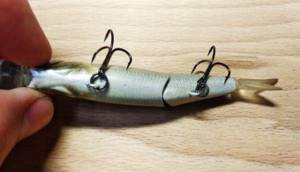
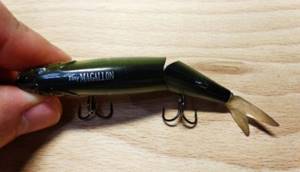
Suspender wobblers: purpose and design
Wobblers of this type are divided into shallow and deep-water.
Shallow water
The first model of shallow water suspender, which proved to be catchy and gained popularity among anglers, is called RAPALA Husky Jerk. This bait takes some getting used to and may take some time to master. If you use simple uniform wiring, then predatory fish will rarely pay attention to the wobbler.
Particles that are found in any liquid form a suspension if they have a similar density. An example is liquid paint. To achieve this effect, suspenders are made from materials such that their density is close to the density of water.
During a pause in the retrieve, such a wobbler hangs in one place, after which it may begin to slowly sink (this depends on its marking). In this case, the balance can be easily upset. If you tie a floating wobbler to a metal leash, it will turn into a sinking one. Some anglers deliberately overload the suspender so that it goes deeper and attracts the attention of fish that stay near the bottom. The effectiveness of this tactic can be questioned, since such a wobbler sinks too slowly.
deep sea
Over time, deep-sea lures appeared on the market. The popular models DUEL 3D-100 and 3D-150 differ from each other only in the length of the blade. The longer the blade, the deeper the wobbler sinks. Model 3D-100 sinks to a depth of 1 m and adheres to it throughout the entire wiring. Compared to the Husky Jerk, this wobbler is equipped with a larger blade that is raised relative to the body.
Model 3D-150 sinks to a depth of 1.5 m and remains stable. If the average depth of the reservoir is approximately 2 m, then this wobbler will move near the bottom. The RAPALA Shad Rap RS Suspender is equipped with an even larger blade that allows you to dive to a depth of 3 m. The RAPALA Down Deep Husky Jerk model goes down to more than 3 m.
To fish with such baits, the angler must have an idea of the depth of the reservoir. Each model has its own trajectory, which can be changed only within small limits.
Varieties
The fact that the wobbler belongs to the category of suspenders is indicated by the “SP” marking, which is applied to its belly or back, as well as the packaging in which the bait is supplied. It is impossible to confuse it with floating or sinking models, designated “F” and “S”, respectively.
An inexperienced fisherman may be confused by other markings:
- SF – slow floating;
- SS – slow sinking;
- SSF – super slow floating;
- SSS – super slow sinking.
Wobblers Lucky Craft
The last two types of baits can be safely classified as suspenders, since any model will sink or float to some extent. There are no wobblers with absolutely zero buoyancy.
It is worth noting that each producer has a different attitude towards the concept of “suspending”. And even within the assortment, individual models declared by the suspender may differ in buoyancy, since a specific idea is incorporated into a specific bait that determines its purpose and performance characteristics.
Some manufacturers, when developing pike baits, often take into account the use of a steel leash. Therefore, a wobbler directly tied to the fishing line begins to float to the surface during pauses, misleading the fisherman, especially the inexperienced one.
Some models are focused on search fishing and long-distance casting. That's why they slowly sink when they stop. And if you attach such a bait to a long, powerful leash, it will completely turn into a completely sinking bait.
Based on the above, before buying a wobbler you need to:
- Carefully study its performance characteristics.
- Search the Internet for reviews from anglers about their experience using a specific bait. Fortunately, you can now find high-quality text and video reviews of any model.
- Chat with experienced fishermen live, if possible.
- Consult the seller.
- And only then make a decision about the feasibility of the purchase.
After purchasing a suspender, it is advisable to first test it at home in a bucket of water or in the bathroom. Choose the optimal fastener or leash for the bait so that it really hangs.
Important! Any suspender is a unique bait, the idea of which must be understood in order for it to show maximum results.
Then the bait is tested in field conditions on a reservoir. It is necessary to decide on the best wiring for the wobbler, at which it opens up as much as possible and begins to play realistically. Afterwards, secondary working animation techniques are selected to add variety to the behavior of the suspender in the absence of bites.
Varieties and markings of baits
Manufacturers of suspenders can equip them with 2 different markings: SP or SSS. The SP (Suspending) marking means that the wobbler has neutral zero buoyancy. During a pause in the wiring, it hangs in the water column, neither rising nor sinking. The SSS (Super Slow Sinking) marking means that the wobbler will begin to slowly sink after stopping.
As practice shows, baits do not always correspond to their markings. The wobbler is affected by many different factors, such as water temperature, salt concentration, weight of the leader and main line. All these factors can change the behavior of a wobbler in the water column.
Some manufacturers indicate on the packaging the conditions necessary for the normal operation of wobblers. In this case, baits receive additional markings SP+ or SP-, which indicate that the bait has a tendency to sink or surface.
There are also hybrid baits that combine the characteristics of 2 different classes (for example, minnow suspender and crank suspender wobblers). Such hybrids expand the capabilities of the spinner and allow him to choose the optimal bait for certain fishing conditions.
Types of suspenders and their markings
It is logical that a wobbler cannot remain suspended for hours. It either sinks slowly or floats up. Most often, the wobbler still sinks. Why? Yes, because other factors also affect it: the characteristics of the water and the accessories we use as fishermen. For example, various fasteners and metal leashes. They add extra weight and disrupt your balance. This is where this property of sinking comes from, although it should hover. It is no coincidence that some models of floating wobblers, when used with metal leads and fasteners, also turn into suspenders.
In another case, manufacturers specifically include in it the ability to sink slowly, and then such a suspended wobbler will be labeled SSS. This is an abbreviation for the English words super slow sinking, i.e. very slowly sinking.
Wobblers with neutral buoyancy, that is, those that actually hang in the water column for some time, are designated SP from the English word suspending.
How to make a suspender from a wobbler?
To make a suspender from another type of wobbler, you will need the following components:
- syringe without needle;
- small automatic drill (for example, manicure);
- stopper from a water balloon or squeaky toy;
- bathtub or any similar container filled with water.
The back of the wobbler must be drilled so that the hole matches the selected plug. Using a syringe, water is poured into the hole. After filling the wobbler, the hole is closed with a stopper and the homemade suspender is placed in a container of water. If it sinks too quickly, then the amount of liquid inside the housing needs to be reduced.
If desired, the wobbler can be supplemented with a weight, which is attached with resin. If the suspender is too “playful” (it jerks strongly to the sides during the wiring process), then it can be made more balanced by placing a weighting agent near the blade.
And when the wobbler is not playful enough, the weight must be placed near the center of gravity. Tungsten alloy beads can be used as weights for small suspenders. Lead is used to make large wobblers sinkable.
How to tie correctly?
Some fishermen believe that there must be a metal leash between the wobbler and the main fishing line. Others disagree with this statement, since a rough metal leash negatively affects the quality of the suspender's play.
Wobbler manufacturers recommend using fishing line. But the problem is that in our reservoirs there is an abundance of pike, which can easily bite fishing line and even braided thread with its sharp teeth. For this reason, anglers who do not use metal leaders often lose expensive baits.
According to statistics, approximately every fourth pike bite on a wobbler tied with a fishing line ends with the bait breaking off.
The use of fishing line leashes is justified only in those reservoirs where pike are not found for some reason, but there are other types of predatory fish, such as asp and chub. On the other hand, a metal leash can ruin the performance of a wobbler, especially a small one. If you are using a small suspender that needs to hover in the water column, then when using metal it may begin to sink. The play of large wobblers depends less on the weight of the leash.
Definition
Suspender (“Suspend” or “Suspending”) translated from English means “hanging”, “stopping”, etc. In other words, this is a bait with zero buoyancy, which, during pauses during retrieval, hangs in the water column, does not sink to the bottom and does not float to the surface.
Suspender wobbler is an intermediate phase between sinking and floating bait. Its neutral buoyancy is achieved through precise balancing, which not all manufacturers can achieve. Therefore, it is not surprising that Japanese brands are the undisputed leaders in this direction.
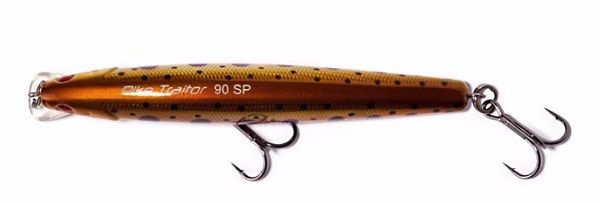
The suspender is marked with the letters “SP”
What does zero buoyancy give? After splashdown and the start of the drive, the wobbler reaches the working horizon, which is determined by the size and angle of inclination of the blade. The fisherman performs its animation, usually jerky, forcing the suspender to play. During pauses, the bait does not begin to rise up or go to the bottom like a stone - it hangs in the thickness. At the same time, it performs rocking and damping oscillations. Such behavior of the object cannot leave a predator indifferent, even a passive one who did not plan to feed at the moment.
Suspender wobblers have the following advantages:
- the ability to catch a passive predator;
- suitability for various fishing conditions;
- many animation options for one bait.
In addition, wobblers with neutral buoyancy are available in a wide range. Mostly these are minnows. Less commonly, shad and compost are used as suspenders. Cranks and rattlins, on the contrary, are produced only in floating or sinking versions.
It must be understood that the concept of neutral buoyancy is very subtle. Any suspender can easily turn into a sinking bait if you add a heavy leash or a large fastener to the rig. Moreover, the smaller and lighter the wobbler, the more delicately you should approach this issue.
Note! Sometimes experienced fishermen change the properties of floating wobblers in a similar way, turning them into suspenders.
On our reservoirs, suspenders are used for pike fishing. It is the spotted beast that is the main object of hunting with these baits. In addition to this, wobblers with neutral buoyancy are used for fishing for perch, asp, and, less commonly, pike perch and trout.
Advantages of fishing with suspenders
Predatory species of fish perform the functions of orderlies of the reservoir. First of all, a predator tries to catch a wounded or sick fish, because it is easier to catch up with it. For this reason, pike and other species pay best attention to lures that move slowly and stop periodically.
Fishermen often observe how a predator chases a spoon or wobbler for a long time, but after a while, for some reason, turns around and swims away in the opposite direction. This picture is most often observed in late autumn or early spring, when the water is still too cold.
The mobility of fish directly depends on water temperature. In the cold season, pike, even with all its desire, will not be able to catch up with prey that moves too quickly.
The peculiarity of the suspender is that during a pause in the wiring process it realistically freezes in one place, like a tired or wounded fish. The predator perceives such a bait as an easy prey, to catch which it is enough to make a few movements. The big disadvantage of jerk baits in general is that they make sudden movements, which is why they cling to snags or algae.
The nuances of suspender wiring
The basic technique for wiring this wobbler is twitching, i.e. jerk wiring. But, some points are a little different. Since the suspender hangs on pauses, they need to be more emphasized. If, when inserting a regular minnow wobbler, a pause of 1-3 seconds is the norm, then with a suspender the pause value can and even should be increased to 4-8 seconds. Especially if the activity of the pike is low and it refuses to take on a fast retrieve.
So, when going fishing, you should definitely put several models of suspender wobblers in the box. If the predator is passive, then it is likely that a wobbler hovering during pauses will help you get away from zero and still catch a fish.
Suspender wiring path
How to properly operate a suspender?
Take a look at Fig. 1 and you will see that the wiring trajectory includes 3 phases: diving, the actual working wiring and raising the bait. In shallow-water suspenders these phases are smoothed out, while in deep-water ones they are quite pronounced.
Fig.1. Suspender wiring trajectory: a) RAPALA Husky Jerk, b) DUEL 3D-150, c) RAPALA Shad Rap RS, d) RAPALA Down Deep Husky Jerk.
In the first phase, the wobbler dives to the desired depth and at the same time approaches the fisherman at a certain distance: from 0.5 m for shallow-water models to 3 m or more for deep-water wobblers. As a rule (exceptions will be discussed below) this phase is preparatory - there are practically no bites here.
When the wobbler reaches the designed depth, the actual working wiring begins, where a good bait goes strictly within the specified horizon. It is in this area that the vast majority of bites occur. Depending on the casting distance, the working line can range from 2-3 m to 20-30 m or more.
And finally, already close to the angler, the wobbler begins to rise to the surface. This phase is no less interesting, since bites are quite frequent here. Apparently, the predator is afraid that the prey near the shore may hide or escape, so it often decides to bite literally under its feet. This means that the fisherman needs to be attentive until the very end.
Including a suspended wobbler in the game
Now let's move on to the actual wiring. First of all, we will try to evaluate the nature of the game of the wobbler used. After all, the first movement we will need to “turn on” it, that is, introduce it into an oscillatory movement.
This can be done by rotating the reel, moving the rod, or both. I recommend first of all trying to quickly rotate the reel, leaving the rod in the working position, ready for hooking. True, some models of suspenders require more energetic twitching (twitching), then you will have to connect the rod to the process. But short and sharp jerks (jerking) are carried out only with a rod.
Why do you need to use the coil in the first place? The fact is that after pulling and especially jerking, the wobbler floats a short distance by inertia before stopping. But this is enough for the line to noticeably weaken and contact with the bait to be lost for a short time. Unfortunately, it is at this moment that the vast majority of bites occur, and we are least prepared for them.
If the bait was pulled with a reel, then the rod remains in the working position and has a sufficient range of motion for normal hooking. If the jerk was carried out by a rod that moved back, then the hook is weak. And this is perhaps the biggest drawback of all jerk baits, including suspenders.
You can partially avoid negative consequences in the following ways. Firstly, after several quick turns of the reel, we make another slow half-turn, which removes excess slack in the line. The same effect can be achieved by raising the rod slightly, but at the same time there must be sufficient range for hooking. And the rod itself for fishing with suspenders is preferably longer.
Secondly, it is preferable to take a braided fishing line, because due to its inextensibility, it allows you to more clearly feel the bite and make a sharper hook.
After checking it near the shore, it becomes clear how much force and duration of pulling is needed for the wobbler to start oscillating. After this, the bait can be stopped, or you can spend some more time.
Suspender wiring speed
The forward movement of the suspender is determined mainly by the appetite of the fish. We already know that an active predator attacks even a constantly moving wobbler, but a passive predator prefers slow movement of the bait with stops.
Therefore, the general rule is this: the more active the fish, the longer the forward “steps” of the suspender and the shorter the stops. And vice versa, the more passive the predators, the shorter the “steps” with longer pauses our bait should take. Often during a drive the duration of pauses even exceeds the total time of forward movement.
Related to this is another drawback of the suspender - its “slowness”. After all, instead of one wiring of the suspender, you can manage to conduct a regular wobbler 2-3 times. It is clear that such a loss in time makes the use of a suspender rational only in two cases: when the fish sites are known or easily determined, and also when the fish are lazy and do not take ordinary baits well. In other cases, you can suffer in vain, while others will make three times as many casts and can catch twice as many fish, that is, quantity will outweigh quality.
If the fish have accumulated in some area, play, come out to the bait, but don’t take it - it’s time for a suspender! And the lazier the predator, the fewer competitors the suspender has among other baits.
Suspender rating
- The rating of the best suspenders is headed by the RAPALA Husky Jerk model, 8 cm long. This bait is well suited for guiding on the border of aquatic vegetation, as well as for small rivers. This suspender is suitable for uniform retrieving with stops and twitching. Experienced spinning anglers have in their arsenal 2-3 copies of such a wobbler with different colors, since the color of the Husky Jerk can play a decisive role in attracting predatory fish.
- In second place are similar models DUEL Hardcore JB-90 and 65SP. These baits are interesting because during the retrieval process they tilt down and drop a few centimeters, after which they return to their original depth. For these baits, it is best to use twitching, but in some cases, even retrieving with stops also shows effectiveness.
- Third place goes to the miniature bait ZIPBAITS Khamsin 50SP DR, designed for twitching. This model showed itself especially well as a bait for catching small pike in small reservoirs. But there have been cases recorded when large fish also responded to such a suspender, which for this bait means that it is universal.
Wobblers
The fact is that wobblers may not be liked by those fishermen who do not have a sufficient assortment of them. It’s not enough to have one or two wobblers; you need to find a suitable one that will show its effectiveness. I have enough wobblers, however, I only use 3-4 types with different colors. This is enough for me. The rest are simply stored in boxes for non-standard fishing.
A wobbler is an irreplaceable thing in trolling. Maintains depth, has an attractive play, and comes in a variety of colors.
Any models of wobblers, both sinking and floating, are suitable for trolling; let’s not forget suspenders. A wobbler is not a bait for a beginner, but I would advise a beginner to start mastering this bait with more unpretentious models, which are still available. These are wobblers with a wide lip plate and powerful action. High quality wobblers are made by the following companies: RAPALA, HEDDON, SUICK, BOMBER, NILS MASTER, MIRROLURE, APEX, MANN'S, HALCO. RAPALA has a large assortment of wobblers. Wobblers of this famous company are most common in Russia, and other models of foreign companies, except OPM, SALMO, NILS MASTER and HALCO, can not yet often be found in our fishing stores (the desired assortment is not visible), I, of course, do not mean wobblers of unknown companies , which you can meet and buy, but then regret having made such a purchase.
Video: How to make a suspender from a floating wobbler
From the video you will learn how to make a suspender from a floating wobbler with your own hands.
Suspenders come in bright and natural colors, which allows you to choose the right shade for cloudy or clear water, with active and slow play, with different casting depths. They easily fly long distances. These baits can freeze in the water column and slowly sway when the scroll starts slowly, which provokes sluggish predators to attack.
